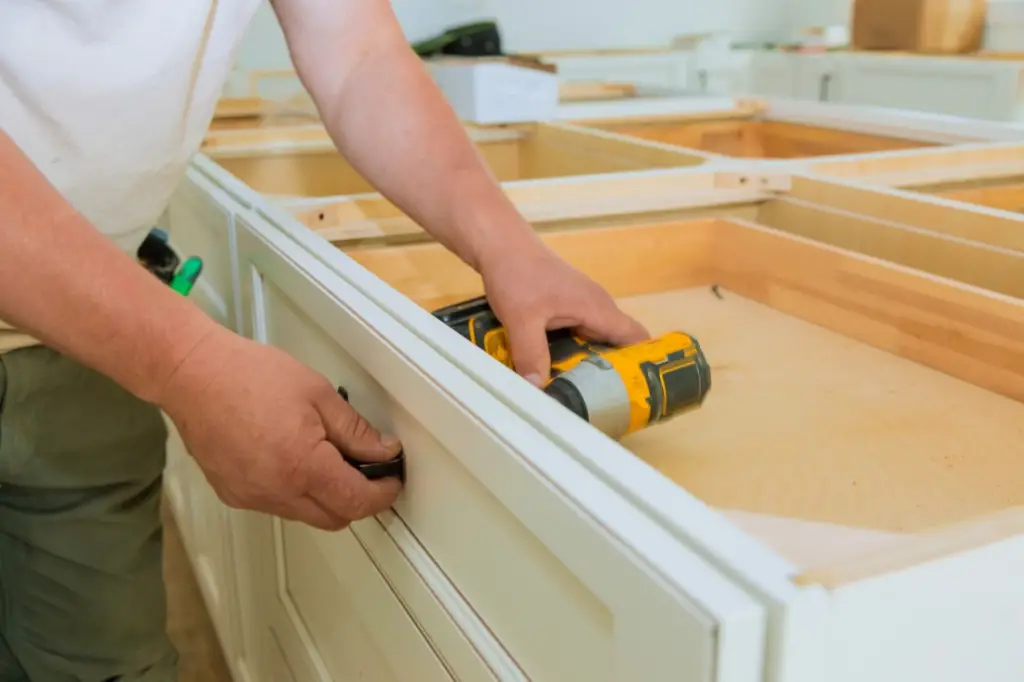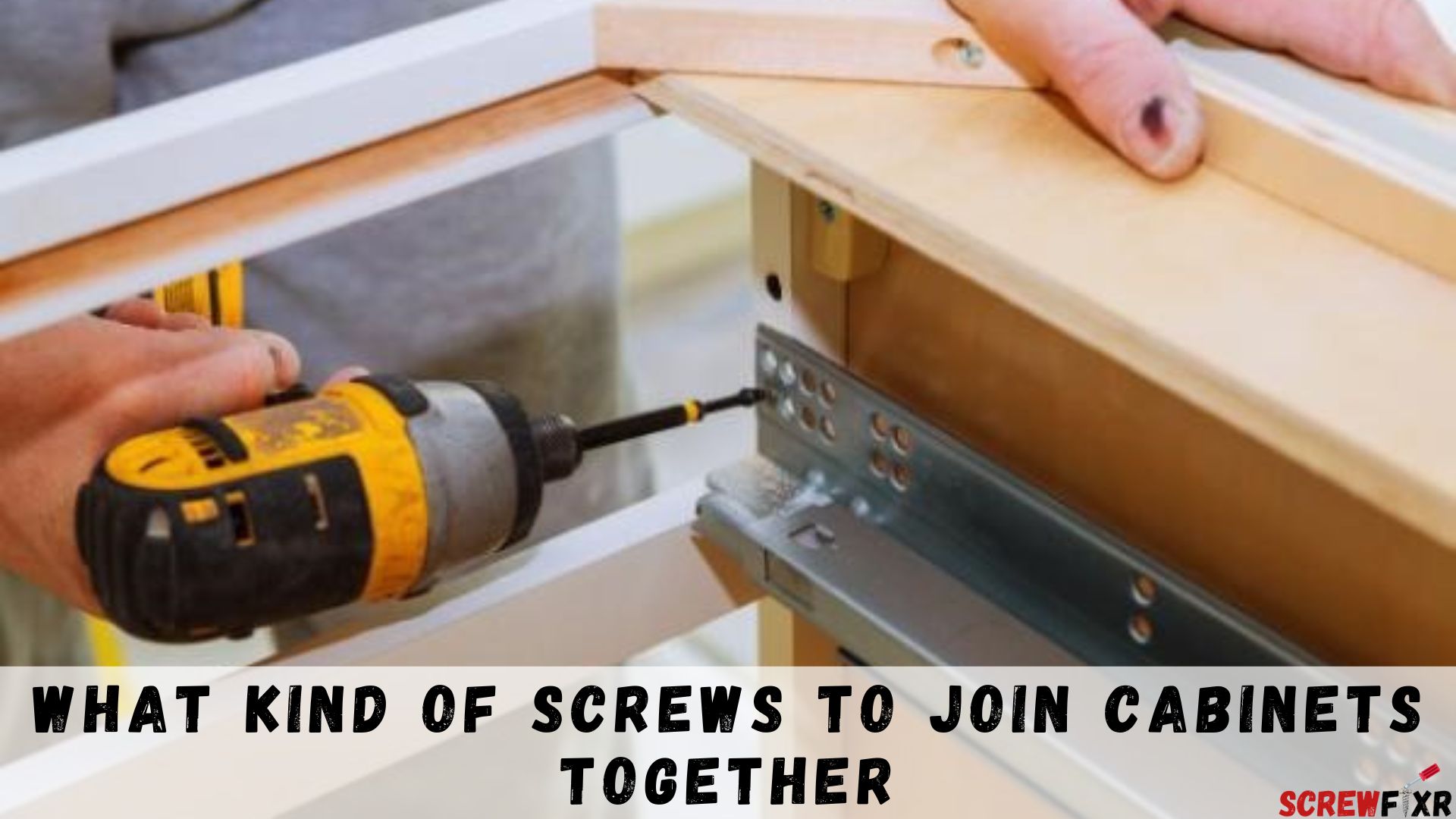When it comes to cabinet assembly, choosing the right screws can make all the difference. You want your cabinets to be not only functional but also durable and long-lasting. In this guide, we’ll delve into the world of screws for cabinet joinery and provide you with valuable insights to help you make informed decisions about what kind of screws to join cabinets together. Whether you’re a DIY enthusiast or a professional carpenter, understanding what kind of screws to use is essential for a successful cabinet project.
What Kind of Screws to Join Cabinets Together

Screws are crucial components in cabinet construction, as they hold the entire structure together. Let’s explore the various aspects of selecting the right screws for your cabinet project.
Types of Screws
When it comes to joining cabinets together, not all screws are created equal. Each type of screw serves a specific purpose and offers distinct advantages. In this section, we will explore five different screw types commonly used in cabinet assembly:
1. Wood Screws
Description:
Wood screws are among the most versatile screws used in woodworking. They are designed for use in wooden materials and come in various lengths, thread types, and head styles.
Suitability:
- Ideal for joining solid wood cabinets.
- Suitable for plywood cabinets when used with pilot holes.
- Used in general cabinet construction where a strong and secure hold is required.
2. Cabinet Screws
Description:
Cabinet screws, also known as cabinet installation screws, are designed specifically for cabinet assembly. They often feature self-drilling tips and flat or pan heads.
Suitability:
- Tailored for attaching cabinets to wall studs or each other.
- Excellent for securing kitchen and bathroom cabinets.
- Designed to prevent wood splitting and ensure a snug fit.
3. Confirmat Screws
Description:
Confirmat screws are specialized fasteners designed for particleboard or MDF cabinet construction. They have deep, coarse threads and a unique shape for maximum holding power.
Suitability:
- Best suited for particleboard or MDF cabinets.
- Provide exceptional stability and resistance to pull-out forces.
- Preferred choice for modern and modular furniture construction.
4. Pocket Hole Screws
Description:
Pocket hole screws are used in conjunction with pocket hole joinery, a method that involves drilling angled holes (pockets) in one piece of wood and then connecting it to another using these screws.
Suitability:
- Ideal for assembling cabinets with hidden joints.
- Great for DIY enthusiasts looking for a quick and secure connection.
- Suitable for a wide range of cabinet materials, including plywood and hardwood.
5. Dowel Screws
Description:
Dowel screws have threads at both ends and are commonly used to join two pieces of wood together by drilling matching holes and inserting the screws to create a strong, hidden joint.
Suitability:
- Effective for assembling cabinets with a clean and concealed look.
- Suitable for cabinets that require disassembly and reassembly.
- It can be used in various cabinet materials, provided that dowel holes are accurately aligned.
Screw Size Matters
Choosing the right size of screws is crucial to ensure the strength and stability of your cabinets. The size depends on the thickness of the cabinet material. Generally, screws between 1 to 1.25 inches work well for standard cabinet assembly.
Factors to Consider When Choosing Screws

Selecting the right screws for your cabinet assembly is a decision that involves several crucial factors. Let’s delve into an in-depth analysis of these factors to ensure you make an informed choice:
1. Material of Cabinet
The material of your cabinet plays a pivotal role in screw selection:
- Solid Wood: For cabinets made of solid wood, traditional wood screws are often the best choice due to their excellent grip and compatibility.
- Plywood: Plywood cabinets can benefit from wood screws but may require careful pre-drilling to prevent splitting. Alternatively, cabinet screws with self-drilling capabilities are suitable.
- Particleboard or MDF: Confirmat screws are ideal for these engineered wood materials, providing exceptional stability and holding power.
2. Load-Bearing Capacity
Consider the weight and load-bearing requirements of your cabinets:
- Heavy-Duty Cabinets: Cabinets that will bear substantial weight, such as kitchen cabinets, may benefit from cabinet screws or confirmat screws, known for their load-bearing capabilities.
- Lighter Cabinets: For cabinets used in less demanding scenarios, like bathroom or laundry room cabinets, standard wood screws may suffice.
3. Aesthetics
The visual appeal of your cabinets is crucial, so think about how screw heads and finishes affect aesthetics:
- Visible Screws: If screws will be visible, select head types that match your desired aesthetic. Roundheads can provide a traditional look, while panheads offer a modern appearance.
- Hidden Screws: For cabinets with concealed screws or where aesthetics take precedence, pocket hole or dowel screws are excellent choices.
4. Screw Length and Diameter
Getting the right screw length and diameter is essential for secure cabinet assembly:
- Length: Screws should be long enough to penetrate the second piece by about 2/3 of its thickness. Avoid using overly long screws, as they can damage the cabinet’s interior.
- Diameter: Match the screw diameter to the pilot hole size. A mismatch can lead to instability or splitting.
5. Cost and Availability
Budget and accessibility are practical considerations:
- Cost-Effective Solutions: Wood screws are generally cost-effective and widely available, making them a suitable choice for many projects.
- Specialized Screws: confirmat screws and cabinet screws may be more expensive but are essential for specific applications. Ensure they fit within your project’s budget.
- Local Availability: Consider the availability of your chosen screws in your local hardware store. If a particular type is challenging to find, it may impact your decision.
By carefully analyzing these factors, you can tailor your screw selection to meet the unique needs of your cabinet project, ensuring both functionality and aesthetics are well-balanced.
Installation Techniques
Now that you know about the types and sizes of screws let’s discuss some essential installation techniques:
- Pre-Drilling: Always pre-drill holes for your screws to prevent wood splitting or damaging the cabinet material.
- Countersinking: To achieve a flush surface, countersink your screws by creating a depression for the screw head to sit in.
- Pilot Holes: Use pilot holes to guide your screws accurately into the wood, ensuring a snug fit.
- Torque Control: Avoid over-tightening the screws, as this can weaken the cabinet joints. Use a torque control tool for precision.
Frequently Asked Questions

Can I use regular screws for cabinets?
Yes, you can, but it’s recommended to use screws designed for cabinet assembly, as they provide better support and durability.
What’s the ideal screw material for cabinets?
Stainless steel screws are an excellent choice, as they are corrosion-resistant and won’t rust, ensuring the longevity of your cabinets.
How do I determine the right screw length for my cabinet project?
To find the correct screw length, measure the combined thickness of the materials you are joining. Add an extra 1/4 inch to ensure the screw goes deep enough for a secure hold without protruding. For example, if you’re joining two 3/4-inch thick boards, use screws that are at least 1.5 inches long.
Should I glue cabinets in addition to using screws?
Yes, applying wood glue along the joints before screwing them together enhances the cabinet’s strength and stability.
Can I use screws on particleboard cabinets?
Yes, but make sure to use screws specifically designed for particleboard, like Euro or Confirmat screws.
How do I prevent screws from splitting the wood?
By pre-drilling pilot holes and ensuring that the screws’ diameter is slightly smaller than the hole, you can prevent wood splitting.
Conclusion
Selecting the right screws for joining cabinets together is a crucial step in ensuring the strength and longevity of your cabinets. By understanding the types, sizes, and installation techniques, you can embark on your cabinet project with confidence. Remember to choose the appropriate screws based on the cabinet material and always prioritize precision and stability.


